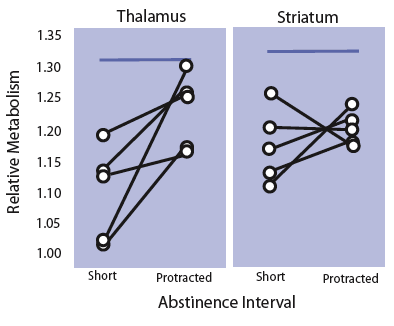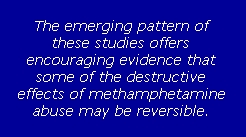Long-Term Abstinence Brings Partial Recovery From Methamphetamine Damage
Download PDF Version What is PDF?
Patrick Zickler
Patrick Zickler is a Staff Writer for NIDA NOTES.
Source: NIDA NOTES, Vol. 19, No. 4, December, 2004
Public Domain
Table of Contents (TOC)
Article: Long-Term Abstinence Brings Partial Recovery From Methamphetamine DamageReferences
Methamphetamine abusers who remain abstinent for 9 months or longer show modest improvement in performance on some tests of motor skill and memory. They also appear to recover from some of the drug’s damaging effects on metabolism in the thalamus, a brain region involved in relaying and filtering sensory, motor, and emotional signals between the cerebral cortex and other brain structures. Drug-related deficits appear to persist longer, however, in another brain region, the striatum, which plays a role in reward-linked motivation, planning, and impulse control.

Relative metabolic activity (regional metabolic rate compared with rate for entire brain) was reduced in the striatum and thalamus of five methamphetamine abusers, compared with nonusers, after short abstinence. After protracted (more than 9 months) abstinence, thalamic metabolism returned to normal levels (blue line indicates median level for healthy comparison subjects). Striatal metabolism showed no recovery after abstinence.
Dr. Gene-Jack Wang and colleagues at the Brookhaven National Laboratory in Upton, New York, evaluated metabolism and neuropsychological function in a small group of methamphetamine abusers (three women and two men; average age, 29) who entered treatment as part of a California drug court rehabilitation program. In tests following an abstinence of 2 months or less, the methamphetamine abusers scored lower than nonabusers, though within normal ranges, on tests of gross motor function (timed while walking in a straight line for a defined distance), fine motor coordination (inserting pegs into small angled holes), memory (learning and recalling lists of unrelated words immediately, after a delay, and after a distraction), and attention (identifying numbers previously associated with symbols). When tested again after an additional 9 months of abstinence (average total abstinence was 17 months), these methamphetamine abusers had improved performance on three of five neuropsychological measures: the timed gait test, symbol-digit association, and delayed word recall. The changes in test scores correlated with improvement in thalamic metabolism.
The researchers used positron emission tomography (PET) to evaluate methamphetamine’s effect on metabolism in the thalamus and striatum. This technique involves injection of a radioactively labeled form of glucose, the body’s basic metabolic fuel. Differences in activity among brain regions are reflected by different rates of glucose consumption. PET imaging captures the signals emitted by the radioactive glucose molecules; the strength of the signal indicates the intensity of metabolic activity. The methamphetamine abusers had lower metabolism in the thalamus than did nonabusers when evaluated after the short abstinence. However, the abusers’ thalamic metabolism was not significantly different from the nonabusers’ after the longer drug-free period, suggesting that drug damage in this brain region is reversed with abstinence. "The correlation between increased thalamic metabolism and the tendency to better scores on some tasks suggests that the thalamic changes are functionally significant," Dr. Wang says.
 After a short abstinence, metabolism in another brain region, the striatum, also was lower in methamphetamine abusers than in participants who had never used the drug.
In contrast to the findings with thalamic metabolism, however, abusers did not show recovery of striatal metabolism after the longer abstinence.
After a short abstinence, metabolism in another brain region, the striatum, also was lower in methamphetamine abusers than in participants who had never used the drug.
In contrast to the findings with thalamic metabolism, however, abusers did not show recovery of striatal metabolism after the longer abstinence.
The emerging pattern of these studies offers encouraging evidence that some of the destructive effects of methamphetamine abuse may be reversible. The brain may respond to damage by rerouting some connections. Earlier work made it clear that methamphetamine causes damage to brain circuits that rely on the neurotransmitter dopamine. "Recovery of thalamic metabolism could indicate in part a compensatory adaptation to the loss of these dopamine cells by increased activity in other brain cells that extend from the striatum into the thalamus," says Dr. Joseph Frascella of NIDA’s Division of Clinical Neuroscience, Development, and Behavioral Treatments. "But there is a troubling indication that some of the drug’s damage is longer lasting. The persistent reduction in striatal metabolism seems to reflect the drug’s toxicity to dopamine terminals in that region."
This lasting deficit in striatal metabolism may hold a clue to the cause of other methamphetamine-related effects. In some followup studies, methamphetamine abusers report lack of motivation and anhedonia—an absence of pleasure in response to acts that had previously been pleasurable—as long as 2 years after their last use of methamphetamine. Motivation and pleasurable response are both governed in part by activities in one specific region of the striatum, the nucleus accumbens, Dr. Wang explains.
"The anhedonia and decreased motivation reported by some abstinent abusers may be the result of reduced activity—indicated in this study by reduced metabolism—in the nucleus accumbens, which has a high density of dopamine cells," says Dr. Wang.
Wang, G.-J., et al. Partial recovery of brain metabolism in methamphetamine abusers after protracted abstinence. American Journal of Psychiatry 161(2):242-248, 200


